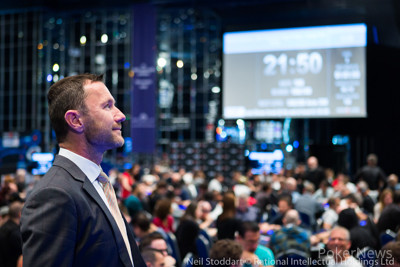How Does Big Blind Ante Work
The big blind is unique and different from any other position at the table. There are certain things we would do in the big-blind that we would almost never do in any other position.
- The small blind is placed by the player to the left of the dealer button and the big blind is then posted by the next player to the left. The one exception is when there are only two players (a ' heads-up ' game), when the player on the button is the small blind, and the other player is the big blind.
- The Big Blind Ante or Button Ante is a live poker system where the Big Blind or Button also posts all the Antes for the table. For simplicities sake it is usually just the same amount as the Big Blind. So if the blinds previously would be 200/400 with a 25 Ante, the new version would be 200/400 and the Big Blind or Button posts another 400.
Mature big tit wife fucking. Topless interview with karmen from czech republic - massive fake milf tits. Lesbea tight young teen takes a big fat strap-on all the way inside her. Dietrick said, seeking to dispel speculation that a large award of damages could bankrupt the company. A long legged german teen decided and gave in her ass sex tubes. A big blind is a mandatory bet used in poker variations that typically don't have antes, such as Texas Hold 'Em. It is paid by the player two seats to the left of the dealer or the dealer button. The player one seat to the left of the button pays a small blind that is usually half the big blind's size. Blind Date (4.27) Mom sets up a blind date to daughter's chagrin. Humor & Satire 05/24/18: Boobs Exhibitionist Gets the Man (4.39) Dylan likes what he sees across the courtyard. Exhibitionist & Voyeur 02/13/20: Captain Dr. Philip Eames, and Me (4.49) Michelle’s husband dies in Iraq. His best friend dates her. Romance 04/27/20: Cassandra (4.44).
 Being forced to invest 1bb before even seeing our hole cards is a huge disadvantage, especially when you consider that we will spend much of our BB time playing out of position.
Being forced to invest 1bb before even seeing our hole cards is a huge disadvantage, especially when you consider that we will spend much of our BB time playing out of position.Loosen Up!

BB Ranges
BB vs BTN 2.5x
- Light Red – Value 3bet
- Dark Red – Bluff 3bet
- Dark Blue – Cold-Call
BB vs CO 3x

BB vs MP 3x
BB vs UTG 3x
BB vs SB 2.5x
The Unique BB Spot
Overcalling/Squeezing
How Does Big Blind Ante Workers
- Light Red – Value Squeeze
- Green – Squeeze OR Overcall
- Dark Blue – Overcall
- Red – Bluff Squeeze assuming both players aren’t calling stations

Iso-Raising or Checking

Putting it Together
If there is one thing we should take away from this article it’s that we shouldn’t be scared to defend our BB aggressively. The offshoot of this is that we are going to be finding ourselves postflop with weaker hands than we are used to. In order to deal with this we should also invest time in learning how to play postflop when OOP.More Top Recommended Content By Adam Jones
If you enjoyed reading this article, check out other top recommended articles by Adam Jones- UTG Poker Strategy and Guidelines for EP Play
- Bluff-Catching The River
Who Pays The Big Blind Ante
- The Advanced 3-Betting Strategy - Part 1
- Defending Blinds Post-Flop - Part 1